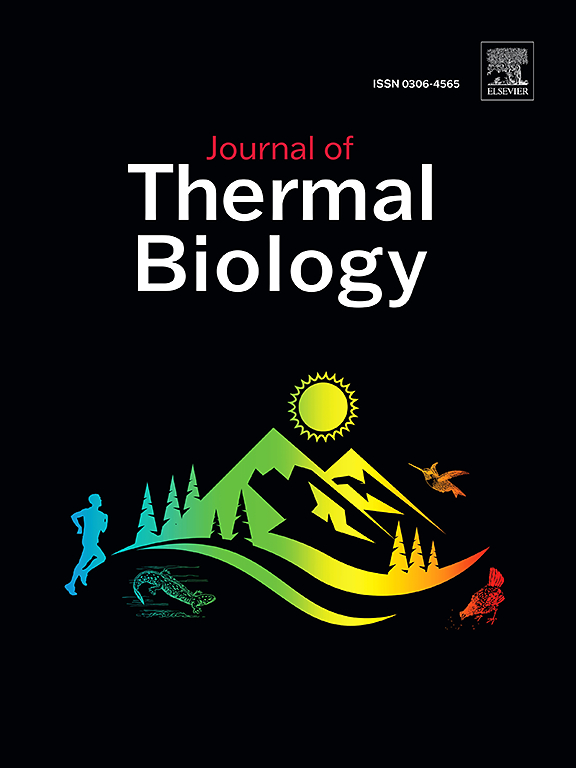一种用于预防劳累性中暑的轻型水循环冷却毯的评价
IF 2.9
2区 生物学
Q2 BIOLOGY
引用次数: 0
摘要
运动性中暑(EHS)被认为是运动员和体力劳动者猝死的主要原因。快速冷却治疗是预防和管理运动引起的热疗的主要策略,强调了对快速有效冷却设备的需求日益增长。目的研究一种轻型水循环冷却毯的冷却性能和效果。方法本研究采用随机交叉设计,招募12名从事专业户外耐力运动训练的男性志愿者。参与者在高温室内(环境温度≈40°C;相对湿度[RH]≈40%),然后立即进行15分钟的冷却试验(环境温度≈31℃;rh≈65%)。在这个冷却阶段,参与者要么躺在轻质水循环冷却毯上(LWC条件),要么接受自然冷却(CON条件)。随后,所有参与者都被要求在与第一轮相同的环境条件下完成另一项3公里的耐力运动和随后的冷却阶段。分析包括测量核心温度(Tcore)、心率(HR)、皮肤温度(Tskin)、热感觉和感知运动等级(RPE)。结果经过两次冷却后,LWC条件下的Tcore测量值在冷却阶段显著降低。与CON组相比,LWC组在第二次锻炼后记录的Tcore峰值较低。此外,LWC条件下的HR、Tskin、热感觉和RPE均低于CON条件下的后冷。结论轻质水循环冷却毯具有较好的冷却效果,可提高HR和RPE的回收率。该装置可作为高强度运动后的紧急冷却或在极端高温训练期间的恢复间隔的实用解决方案,对运动员和体力劳动者都有好处。本文章由计算机程序翻译,如有差异,请以英文原文为准。
Evaluation of a lightweight water circulation cooling blanket for the prevention of exertional heat stroke
Background
Exertional heat stroke (EHS) is acknowledged as a leading cause of sudden death among athletes and manual laborers. Rapid cooling treatment serves as a primary strategy for preventing and managing exercise-induced hyperthermia, underscoring the growing demand for swift and effective cooling devices.
Objectives
This study aimed to evaluate the cooling performance and effectiveness of a lightweight water circulation cooling blanket.
Methods
This randomized crossover design study recruited 12 male volunteers engaged in professional endurance exercise training outdoors. Participants completed a 3-km exercise session in a hot chamber (ambient temperature ≈ 40 °C; relative humidity [RH] ≈ 40 %), which was immediately followed by a 15-min cooling test (ambient temperature ≈ 31 °C; RH ≈ 65 %). During this cooling phase, participants were assigned to either lay on a lightweight water circulation cooling blanket (LWC condition) or to receive natural cooling (CON condition). Subsequently, all participants were required to complete another 3-km endurance exercise and a subsequent cooling phase under the same environmental conditions as those in the first round. The analysis included measurements of core temperature (Tcore), heart rate (HR), skin temperature (Tskin), thermal sensation, and rating of perceived exertion (RPE).
Results
After two cooling sessions, Tcore measurements were significantly reduced in the LWC condition during the cooling phase. The peak Tcore recorded after the second exercise session was lower in the LWC condition compared to the CON condition. Additionally, HR, Tskin, thermal sensation, and RPE were lower in the LWC condition than those observed in the CON condition post-cooling.
Conclusions
The lightweight water circulation cooling blanket demonstrated effective cooling capabilities and enhanced recovery of both HR and RPE. This device may serve as a practical solution for emergency cooling following intense exercise or during recovery intervals between training sessions in extreme heat, benefiting both athletes and manual laborers.
求助全文
通过发布文献求助,成功后即可免费获取论文全文。
去求助
来源期刊

Journal of thermal biology
生物-动物学
CiteScore
5.30
自引率
7.40%
发文量
196
审稿时长
14.5 weeks
期刊介绍:
The Journal of Thermal Biology publishes articles that advance our knowledge on the ways and mechanisms through which temperature affects man and animals. This includes studies of their responses to these effects and on the ecological consequences. Directly relevant to this theme are:
• The mechanisms of thermal limitation, heat and cold injury, and the resistance of organisms to extremes of temperature
• The mechanisms involved in acclimation, acclimatization and evolutionary adaptation to temperature
• Mechanisms underlying the patterns of hibernation, torpor, dormancy, aestivation and diapause
• Effects of temperature on reproduction and development, growth, ageing and life-span
• Studies on modelling heat transfer between organisms and their environment
• The contributions of temperature to effects of climate change on animal species and man
• Studies of conservation biology and physiology related to temperature
• Behavioural and physiological regulation of body temperature including its pathophysiology and fever
• Medical applications of hypo- and hyperthermia
Article types:
• Original articles
• Review articles
 求助内容:
求助内容: 应助结果提醒方式:
应助结果提醒方式:


